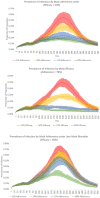This is a preprint.
High-Quality Masks Reduce COVID-19 Infections and Deaths in the US
- PMID: 33532790
- PMCID: PMC7852241
- DOI: 10.1101/2020.09.27.20199737
High-Quality Masks Reduce COVID-19 Infections and Deaths in the US
Abstract
Objectives: To evaluate the effectiveness of widespread adoption of masks or face coverings to reduce community transmission of the SARS-CoV-2 virus that causes COVID-19.
Methods: We created an agent-based stochastic network simulation using a variant of the standard SEIR dynamic infectious disease model. We considered a mask order that was initiated 3.5 months after the first confirmed COVID-19 case. We varied the likelihood of individuals wearing masks from 0-100% in steps of 20% (mask adherence) and considered 25% to 90% mask-related reduction in viral transmission (mask efficacy). Sensitivity analyses assessed early (by week 13) versus late (by week 42) adoption of masks and geographic differences in adherence (highest in urban and lowest in rural areas).
Results: Introduction of mask use with 50% efficacy worn by 50% of individuals reduces the cumulative infection attack rate (IAR) by 27%, the peak prevalence by 49%, and population-wide mortality by 29%. If 90% of individuals wear 50% efficacious masks, this decreases IAR by 54%, peak prevalence by 75%, and population-wide mortality by 55%; similar improvements hold if 70% of individuals wear 75% efficacious masks. Late adoption reduces IAR and deaths by 18% or more compared to no adoption. Lower adoption in rural areas than urban would lead to rural areas having the highest IAR.
Conclusions: Even after community transmission of SARS-CoV-2 has been established, adoption of mask-wearing by a majority of community-dwelling individuals can meaningfully reduce the number and outcome of COVID-19 infections over and above physical distancing interventions.
Conflict of interest statement
Conflicts of Interest/Competing Interests: There are no conflicts to declare.
Figures


Similar articles
-
To mask or not to mask: Modeling the potential for face mask use by the general public to curtail the COVID-19 pandemic.Infect Dis Model. 2020 Apr 21;5:293-308. doi: 10.1016/j.idm.2020.04.001. eCollection 2020. Infect Dis Model. 2020. PMID: 32355904 Free PMC article.
-
Mask-wearing and control of SARS-CoV-2 transmission in the USA: a cross-sectional study.Lancet Digit Health. 2021 Mar;3(3):e148-e157. doi: 10.1016/S2589-7500(20)30293-4. Epub 2021 Jan 19. Lancet Digit Health. 2021. PMID: 33483277 Free PMC article.
-
Mask Wearing and Control of SARS-CoV-2 Transmission in the United States.medRxiv [Preprint]. 2020 Sep 1:2020.08.23.20078964. doi: 10.1101/2020.08.23.20078964. medRxiv. 2020. Update in: Lancet Digit Health. 2021 Mar;3(3):e148-e157. doi: 10.1016/S2589-7500(20)30293-4. PMID: 32869039 Free PMC article. Updated. Preprint.
-
Why the mask? The effectiveness of face masks in preventing the spread of respiratory infections such as COVID-19 - a home testing protocol.J Med Eng Technol. 2020 Aug;44(6):334-337. doi: 10.1080/03091902.2020.1797198. Epub 2020 Jul 27. J Med Eng Technol. 2020. PMID: 32716230 Review.
-
Mask use during COVID-19: A risk adjusted strategy.Environ Pollut. 2020 Nov;266(Pt 1):115099. doi: 10.1016/j.envpol.2020.115099. Epub 2020 Jun 25. Environ Pollut. 2020. PMID: 32623270 Free PMC article. Review.
Cited by
-
Rates of SARS-CoV-2 transmission and vaccination impact the fate of vaccine-resistant strains.Sci Rep. 2021 Jul 30;11(1):15729. doi: 10.1038/s41598-021-95025-3. Sci Rep. 2021. PMID: 34330988 Free PMC article.
References
-
- The New York Times. Coronavirus in the U.S.: Latest Map and Case Count. 2020. [cited 2020 18 Aug]; Available from: https://www.nytimes.com/interactive/2020/us/coronavirus-us-cases.html.
Publication types
Grants and funding
LinkOut - more resources
Full Text Sources
Miscellaneous
